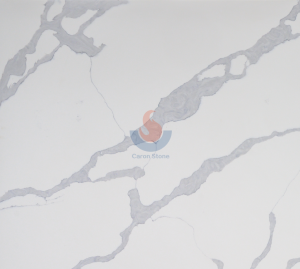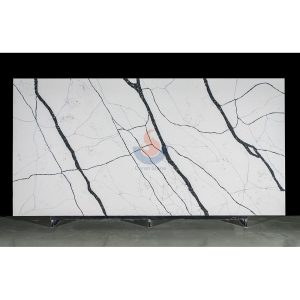In recent years, the quartz plate market has attracted the attention of the global capital market. Relatively mature artificial quartz stone industry clusters have emerged in Guangdong, Hubei, Shandong and other places in China. Leading companies in the industry have demonstrated strong international competitiveness in the fields of automated production, product performance research and development, and pattern design. In the fierce market competition, excellent quality is the key to the invincibility of merchants. So how can quartz plate manufacturers select materials to make the plate quality better?

Calacatta White Artificial Quartz 46
1. Quartz sand particle morphology
Quartz minerals are hard and brittle. The crushed quartz sand has an irregular shape and has more sharp edges. The sharp edges increase the specific surface area, increase the oil absorption rate, and reduce the fluidity of the raw materials after mixing, thereby increasing the amount of resin, which not only increases the production cost, but also affects some of the performance of the plate. Therefore, when quartz plate manufacturers select materials, the quartz particle shape should be as close to round as possible.
2. Fluctuations in raw materials from different batches
The color and particle size of quartz sand and quartz powder between different batches are too different. There will be a large gap in the produced quartz plates, and splicing and use will cause a large gap. Customers cannot accept obvious batch differences. Therefore, manufacturers should try to choose quartz sand and quartz powder from the same batch to make the board better quality.
3. Weathering of quartz sand
The process of making leather grain surface is to use a brush with corundum to rotate and rub the surface at high speed to form an uneven effect. If the quartz sand contains low-hardness particles such as weathered sand, the wear resistance and scratch resistance of the board will decrease. These particles will be brought out by the corundum brush to form pits.
4. Moisture content of quartz sand
As the aggregate of artificial quartz stone, the water content of quartz sand should not be too high, otherwise it will affect the curing of the resin, and the surface of the product will be sticky, the back kraft paper will be relatively moist, and there will be water vapor on the surface of the mold after curing. If the board product is not cured well, it will cause cracking during the later processing.
5. Transparency and whiteness
Black and gray base quartz products need to use transparent sand, so that light can completely penetrate and the black and gray base colors can be presented; high-end imitation natural stone quartz products need to use transparent sand to reflect the texture. The more transparent the board surface is, the closer it is to the texture effect of natural stone. The whiteness of quartz sand obtained from different mineral sources and different processing processes varies greatly. Some have high whiteness and some are yellowish. Whiteness affects the grade of quartz board surface. The higher the whiteness, the higher the grade; the lower the whiteness, the lower the grade. Manufacturers can choose board sand with consistent color according to the color requirements and cost-effectiveness. White is as white as snow and transparent as water.
6. Impurities
White and light-colored board surfaces should not have obvious black spots, yellow skin and other spots; black and gray board surfaces should not have obvious white spots. Quartz sand raw materials for quartz boards should try to choose board sand with impurities removed to ensure that the finished quartz board does not contain any pollution sources and radiation sources, and is green and environmentally friendly. For example: more iron in quartz sand will also cause the quartz plate to have mixed colors, thus reducing the quality of the product.
7. Different grades
The quartz plates produced should try to pursue fewer spots on the plate surface, high whiteness (white products), and pure colors (black, gray and other dark products) to meet the needs of consumers who are constantly pursuing a higher quality of life. The number of spots in the quartz sand and the color of the sand itself determine the grade of the quartz sand. More spots and yellow color will affect the quality and grade of the quartz plate. Therefore, different grades of quartz sand are divided into fine sand, A sand, general sand, C sand, etc. As the grade of quartz sand decreases, impurities gradually increase, and the color of the sand also deteriorates step by step.

Calacatta Quartz 20mm
The quality of quartz plates depends on the strict control of raw materials. From the morphology of quartz sand particles, batch consistency, weathering degree, water content, to transparency, whiteness, impurity content, and the distinction between different grades, every link is crucial. Only by fully grasping these quality checkpoints can quartz plate manufacturers ensure the competitiveness of their products in the market and consumer satisfaction. As consumers continue to pursue quality of life, the high quality standards of quartz plates will become the core of the industry’s sustainable development.




